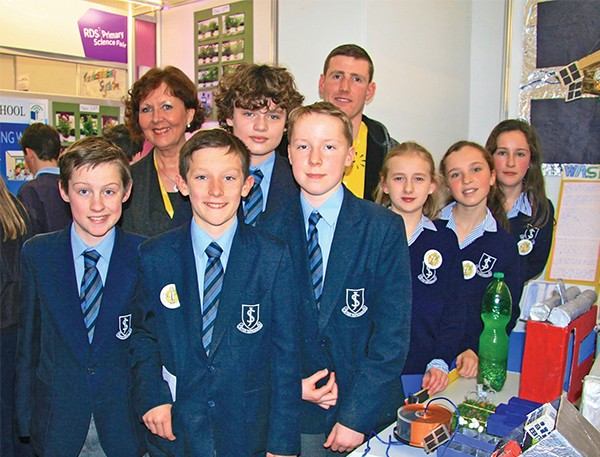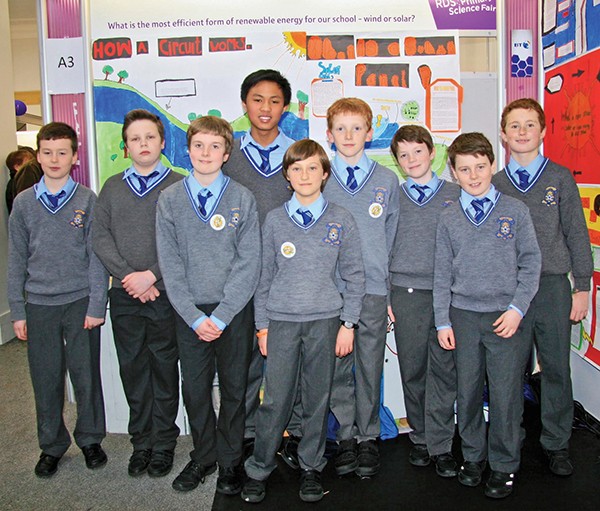
Pictured: 6th class students of John Scottus NS with teachers Margaret Dempsey and Darren Sheils.
The future of Dublin 4 is in safe hands as two local primary schools took part in the Primary Science Fair section of this year’s BT Young Scientist of the Year awards in the RDS.
The schools snapped up two of the coveted 120 stands on offer to primary schools nationwide and made excellent use of the opportunity to display the hard work. According to his classmates, James Crowley is the brainchild behind Sandymount’s Star of the Sea entry. “We were trying to find the most renewable power source for our school, wind or solar?” He explained to NewsFour. “Research involved contacting Met Éireann and I found out that in Sandymount a wind turbine produces more electricity than solar panels. However, the panels proved to be a more suitable and cost-effective option for the school.”
Luke Fitzpatrick, also from 6th class, talked NewsFour through the diagram designed by his classmates. “The river represents the wire and the current is running through it. The rocks are the resistors, which prevent too much power from coming through.” This section of the annual event is designed to inspire primary school children to start asking questions and give them a pre-taster to the main competition, which they will be entitled to enter when they progress to secondary school.
NewsFour spoke to one parent who agreed that it is working. “They worked great as a team. Classmates would come up after school and I wouldn’t even have to tell them to work. They didn’t see it as a task. I’m so proud,” said Luke’s mother Niamh Fitzpatrick.
“They did all the work themselves. We just let them get on with it. I really can’t take any credit at all. Even from a social aspect, they have to present the project to strangers, which is another skill they are learning,” said Seamus Ó Brollacháin, who teaches one of the classes. His counterpart Kevin Munnelly added, “They were working on Physics, Chemistry and Maths to second level standard. It was quite technical but they were brilliant.”
Inception Space Station, or ISS, is the title for the ambitious project undertaken by John Scottus Primary School in Ballsbridge. It is a settlement for 10,000 people in space, complete with tram system, living pods and green spaces.
Jessica Spratt of 6th class was involved with choosing the energy source for the space station. “I chose solar panels over nuclear energy as a lot of nuclear materials are required. The solar panels don’t leave any radioactive waste. I made the solar panels for the space station model.”
Joshua Matthews was in a group with two others and together they made the temperature control and defence plan for the model. “This system keeps the people who are inside comfortable. The gold leaf protects from solar radiation, then under that we have 5–10 metre thick tungsten carbide that can withstand enormous temperatures.”

Pictured: 1st–6th class students from Star of the Sea Primary School.
Photos by Maria Shields O’Kelly.
Aaron Linton took NewsFour through the water treatment and waste disposal plans, which he explained in detail and with great precision. All the plans were presented with step by step illustrations and models of the space station’s infrastructure and living accommodation.
Teachers Darren Sheils and Margaret Dempsey have been accompanying the 6th class students of John Scottus to the Fair for a number of years now. “It’s a very good experience for the children,” said Darren. “They get to see different projects. It’s not just about presenting their own work. The learning experience lies in the understanding of the ideas behind it.”
By Maria Shields O’Kelly

